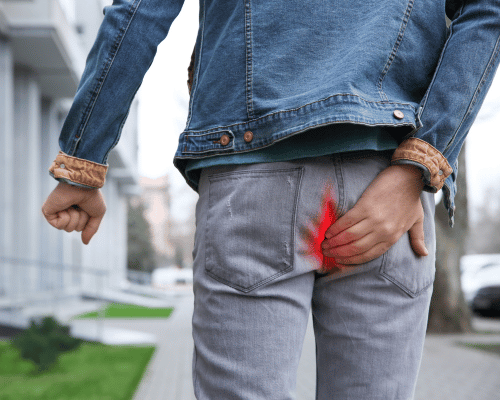Piles Treatment
Laser Piles Treatment In Bangalore
Piles are a common condition, with about 50% of people experiencing them by age 50. They affect both men and women equally.
Understanding the symptoms, types, and treatment options for this disorder is crucial for effective management and relief. Let’s explore this common condition in detail.
Dr. Varun Kumar J. specializes in laser surgery for piles, also known as hemorrhoids. Having years of expertise and a patient-centered methodology, Dr. Varun Kumar J. provides excellent care for people suffering from hemorrhoids. He offers laser piles treatment in Bangalore, ensuring less pain and a quicker recovery. If you are looking for effective and compassionate piles treatment, consult Dr. Varun Kumar J. in Bangalore.
Request A Call Back!!

What are Piles?
Piles, also known as hemorrhoids, are a common yet often uncomfortable condition affecting many individuals. They occur when the veins in the lower rectum or anus become swollen and inflamed.
In this blog, we’ll delve into the symptoms, explore various treatment options available, and answer frequently asked questions to help you better understand and manage this condition.
Advantages of Piles Laser Surgery






Advantages of Piles Laser Surgery






Symptoms
The symptoms can vary depending on whether they are internal or external. Common signs include:
- Pain or Discomfort especially during bowel movements.
- Itching or Irritation around the anal region.
- Swelling or Lumps near the anus.
- Bleeding bright red blood on toilet paper or in the toilet bowl.
- Mucus Discharge from the anus.
Do You have any of these Piles Symptoms?
Causes
- Straining During Bowel Movements: This is one of the most common causes Straining to pass stools due to constipation or diarrhea puts pressure on the veins in the rectal area, leading to swelling and inflammation.
- Chronic Constipation or Diarrhoea: Conditions that cause frequent constipation or diarrhoea can increase the risk of developing piles. Straining during bowel movements aggravates the veins in the anal canal.
- Pregnancy: The increased pressure on the abdomen and hormonal changes during pregnancy can lead to this disorder. They often develop during pregnancy and improve after childbirth.
- Sitting or Standing for Prolonged Periods: Jobs or activities that require prolonged sitting or standing can contribute to the development of this disorder. Sitting for long periods puts pressure on the veins in the lower rectum.
- Obesity: Being overweight or obese increases the pressure on the pelvic area and abdomen, which can lead to this disorder.
- Age: As people age, the tissues supporting the veins in the rectum and anus weaken, making them more susceptible to swelling and inflammation
- Genetics: Some individuals may have a genetic predisposition to developing this disorder. If there is a family history the risk may be higher
- Heavy Lifting: Activities that involve heavy lifting or straining can increase intra-abdominal pressure, contributing to the development of this disorder.
- Poor Diet: A diet low in fiber can lead to constipation, which in turn increases the likelihood of straining during bowel movements and developing this disorder.
Types of Piles
They can be classified into two main types:
1. Internal Piles
They also develop inside the rectum and may not be visible externally Symptoms may include bleeding during bowel movements and protrusion (prolapse) during defecation.
2. External Piles
They form under the skin around the anus and can be felt as lumps, causing pain, itching, or irritation.
Grades of Piles
The severity of this disorder might vary. Based on their size, prolapse severity, and symptoms, they are categorized into grades. The pile grades are as follows:
- Description: Small swellings on the inside lining of the anus.
- Symptoms: Often cause minor bleeding but do not prolapse (come out of the anus).
- Description: Larger swellings that may come out of the anus during bowel movements.
- Symptoms: Can cause bleeding and may prolapse but typically retract back inside on their own.
- Description: Haemorrhoids that prolapse outside the anus during bowel movements or physical activity.
- Symptoms: Can be pushed back inside manually but do not stay inside on their own. These can cause discomfort, bleeding, and swelling.
- Description: Large, prolapsed haemorrhoids that remain outside the anus all the time.
- Symptoms: Cannot be pushed back inside. They can cause significant pain, bleeding, and discomfort, and are at risk of complications like thrombosis (clot formation) or strangulation.
Types of Piles Treatments
- Lifestyle Changes: To soften stools and lower straining during bowel movements, up your daily amount of dietary fibre. Whole grains, legumes, fruits, and vegetables are examples of foods high in fibre. In addition, maintaining soft stools and preventing constipation—which can make this disorder worse—requires drinking plenty of water.
- Medications: You can treat symptoms like itching, pain, and swelling with over-the-counter creams, ointments, or suppositories. To lessen pain and inflammation, these medicines often contain substances like lidocaine, witch hazel, or hydrocortisone.
- Sclerotherapy: A chemical solution is injected directly into the affected area during this process. By minimizing blood flow to the impacted veins, the solution shrinks the affected area. It is relatively painless and helpful in treating.
- Rubber Band Ligation: A common procedure to manage internal piles. By placing a small elastic band at the base of the pile, the blood supply is cut off. The pile withers and falls off over several days. Most of the time, this minimally invasive procedure can be performed in a doctor’s office without the need for anesthesia.
- Haemorrhoidectomy: Large or protruding, internal or external, this can be eradicated during this surgical procedure. Usually, either spinal or general anesthesia is used during the procedure. In severe cases that do not improve with non-surgical treatments, a haemorrhoidectomy is advised.
- Stapled Hemorrhoidopexy (Procedure for Prolapse and Haemorrhoids – PPH): Stapled hemorrhoidopexy, or stapling, treats prolapsed internal piles by using a circular stapler to remove excess tissue and reposition the remaining tissue. This procedure results in less post-operative pain and quicker recovery compared to traditional haemorrhoidectomy
- Laser Treatment: Laser treatment uses a laser beam to minimize or eliminate smaller internal piles. This minimally invasive procedure offers less pain and quicker recovery than traditional surgery but may not be suitable for all types.
Why is Laser Treatment for Piles is Recommended?
Laser treatment for piles has emerged as a preferred option due to its numerous benefits over all above traditional surgical methods. Here are some key reasons why laser treatment is recommended:
- Minimally Invasive: Laser treatment is a minimally invasive procedure that involves no cuts or wounds, making it a safer option with fewer complications.
- Painless Procedure: :The use of laser technology ensures a painless treatment experience, enhancing patient comfort during and after the procedure.
- Quick Recovery: Patients undergoing laser treatment typically experience faster recovery times, allowing them to return to their normal activities sooner.
- Precision: : Laser technology offers precise targeting of affected tissue, reducing damage to surrounding healthy tissue and promoting better outcomes.
- Reduced Post-Operative Pain: Compared to traditional surgery, laser treatment results in significantly less post-operative pain, making the recovery process more comfortable.
Looking for Laser Piles Treatment in Bangalore or Piles Laser Treatment Surgeon in Bangalore?
Meet Dr. Varun Kumar J. is a leading specialist in Piles laser treatment in Bangalore, with extensive experience and a proven track record of successful outcomes. Utilizing the latest laser technology, we ensure precision, minimal pain, and faster recovery times for our patients.
Our approach focuses on personalized care, with tailored treatment plans and compassionate support throughout each patient’s recovery journey. From the initial consultation to post-treatment follow-ups, Dr. Varun Kumar J. and his team provide comprehensive care to ensure the best possible results and patient satisfaction.
For expert laser piles treatment in Bangalore, trust Dr. Varun Kumar J. to deliver exceptional care and advanced treatment options. Our commitment to excellence and patient-centric care makes us the preferred choice for those seeking effective and advanced solutions for piles.
Conclusion
Understanding there symptoms, types, and treatment options is essential for effective management. Whether through lifestyle changes, medications, or surgical procedures, relief from this condition is achievable with proper medical care. If you’re experiencing symptoms, Book a Consultation call now!!

FAQs
Diagnosis involves a physical examination and may include a digital rectal exam or anoscopy.
While typically not dangerous, complications like thrombosis or infection can occur.
Yes, through a healthy lifestyle including a high-fiber diet and avoiding prolonged sitting.
Recovery varies, but most people can resume normal activities within weeks.
If symptoms persist or worsen despite home treatments.
